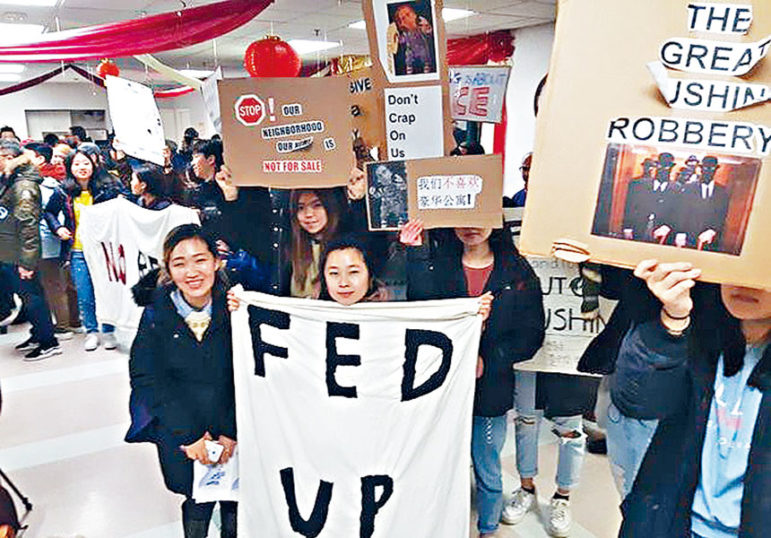
Read the original story in Chinese at Sing Tao Daily
Translated and condensed by Rong Xiaoqing
Despite loud chants of “no more luxury residential buildings” from opponents, Queens Community Board 7 approved a rezoning plan that would green light a waterfront development project by creating a Special Flushing Waterfront District, passing the measure by a 30-to-8 vote at its meeting Monday night.
As part of the Flushing waterfront revitalization plan, the development project would build a complex of nine buildings in a patch of 40 acres dubbed the “Special Flushing Waterfront District” bound by 40th Road on the South, 36 Avenue on the North, College Point Avenue on the East and Flushing Creek on the West. The complex of 1.39 million square feet of mixed-use buildings would include 1,725 apartments as well as retail shops, hotels and offices. It would also provide 1,533 parking spots and 3.14 acre of public space.
The vote triggered anger from many community organizations. Flushing for Equitable Development and Urban Planning, a coalition of local groups that formed to fight the rezoning, said in a statement that the Uniform Land Use Review Procedure (ULURP), the process which the project must go through to receive approval, is lacking when it comes to transparency and public engagement, and shows little commitment to the community. The statement said that what Flushing needs is not luxury residential buildings but senior centers, schools, libraries and affordable housing.
Seonae Byeon, housing organizer at the MinKwon Center, said rapidly rising rents have already left many businesses and residents in Flushing struggling, and it is increasingly hard for low-income people and new immigrants to survive here. The waterfront development project would push them further to the edge.
Congresswoman Grace Meng also raised issues about the project and called for resolving those problems before the plan is voted on by the City Council.
“There are many questions that must still be answered about this project. I have a number of concerns and priority areas that must be better addressed including: the low percentage of affordable housing units; the need to ensure the highest environmental standards and public access for Flushing Creek; a commitment to hire locally with family-sustaining wages and the use of union labor,” Meng in a statement. “[Flushing’s] future growth and success must include the needs of area residents …With this proposal being such a major project for the area, it is critical that the process not be rushed.”
Claire Shulman, former Queens borough president and an enthusiastic promoters of the project, said the development would revitalize the area by re-utilizing the land, storage and buildings that have been left idle, creating a 40-acre waterfront belt that connects Flushing, Willets Point and Corona.
The city’s Uniform Land Use Review Procedure allows the Queens borough president to make a recommendation about the project within 30 days of the community board’s vote. The City Planning Commission will then have up to 60 days to vote on it, followed by the City Council, which has 50 days to review and vote on the project before the mayor can take up to five days to make his decision.









